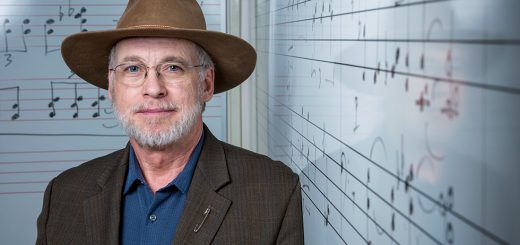Art for the Adoration of the Crowd: “We’re Theater People”
You’re reading this silently to yourself right now—and thank you for that—but please be aware that the theater people desperately miss you.
The theater people—actors, directors, costume creators, set and lighting artists—thrive on human interaction. They listen for your applause and laughter, and they pay close attention to audiences’ silence or even disdain. To them, the nuances of in-person back-and-forth are like nourishment. In 2020 the theater people are so, so hungry.
“Theater is about being in the room with others and responding to who they are, about community,” says Kirsten Brandt, professor of theater. “We’re not done until that other collaborator joins us, with the energy performers get from a live audience. Theater people crave connection,” she says. “We crave being together.”
Actors in the Zoom era are pursuing their art when no one is allowed in the seats. They can gather outdoors, but fall semester was a rough start, Brandt says. “With COVID-19, we’re still able to go outside, even though we’re wearing masks. But with the fires, it’s just really hard to breathe. People are getting claustrophobic!” (Although Brandt’s home of 15 years was spared destruction in August, she evacuated; at the time of this interview, she was working remotely from a friend’s home.)
“Theater has been hit by every plague in the world and survived.”
This fall, Brandt is teaching a new class called Voice and Movement for Performance. Initially planned as a hybrid course with some in-person elements, Brandt decided it would be more accessible purely online. Using software called GoReact, designed to teach performance skills like sign language, students record and upload their performances. Then Brandt can add time-coded feedback. “Instead of me going, ‘Hey at 2:22 when you said this word…’ I can now say, ‘Did you see how your voice modulated here?’ Or, ‘Hey, your eyeline is really great, your focus is really phenomenal there.’” Brandt says she was “super jazzed” about the tool; students were free to practice more. Instead of one take, they could make repeated tries and send her their best. Also, the tool worked on a smartphone. “Accessibility for students is number one for me,” Brandt says. “In GoReact, they don’t need an expensive computer. They just need internet.”
For Brandt’s Practice in Acting and Directing 117 this fall, students are preparing a new work of theatrical vignettes titled Mementoes: Tales for a New Century. They use the Adobe suite of programs to film themselves, also allowing Brandt to add feedback about gestures, stance or voice at timepoints in the video. The pieces are collated for editors for each “pod” of the show, Brandt says. “They take that footage and we can start manipulating it.”
The show is a set of four ten-minute pieces dramatizing contemporary issues using fairy tales and folklore as source material. “These original pieces unleash everybody’s creativity to talk about what’s happening now—immigration (children separated at the border), the “Me Too” movement, giving voice to the voiceless, and the dangers of misinformation. All of the pieces focus on our human ability for transformation.”
In the spring of 2020, preparation for Bertolt Brecht’s Threepenny Opera had to halt. The department reassessed, and the play is to be performed virtually. Students consulted costume designers remotely and created their own costumes. They incorporated scenery and props of their own. “AJ, who played Mack the Knife, had a pool table in his garage,” Brandt says. “Let’s use the pool table!” she suggested. The two-and-a-half-hour musical will be stitched together from individual recorded performances, building scenes that sometimes involved 20 actors singing and moving at once.
Brandt says the summer online teacher training pushed her to practice with some new tools. “I’m trying to avoid Zoom, and I don’t want to do a Zoom show,” she says. Zoom remained essential for teaching and rehearsing, she says, but theater faculty members were striving to bring performers and audiences closer to what live performances really felt like.
“Our students will be walking out of here not just with a theater degree but an interdisciplinary worldview and different tools for working with live audiences,” she says. “We’re not making movies; we’re not making videos—we’re making a new hybrid experience.” The idea was not adding technology to theater, she says, but “performative technologies.” Lovers of theater are all desperate to return “once we’re able to,” Brandt says, “but that’s going to take awhile.”
Innovation comes at a price: Hours of extra work. Like many faculty members, Brandt says she often felt overwhelmed. “I’m doing three classes, but I feel like I’m doing ten,” Brandt says. “It’s challenging, but we’re making do with what we’ve got. And I think we’re pushing the art form in a way that we haven’t had to. There are opportunities.”
Livestreaming could be “a great entry point as we move back into theater,” Brandt says. “Particularly older audiences—or anyone who has a pre-existing condition—may not want to come back in because of COVID-19. But you could buy a ticket and watch it at home.”
Brandt told her students that theater influenced by pandemics was not new. “Theater has been hit by every plague in the world and survived. In fact, we’re doing a show called The Living, which is about the plague of 1665 in England.” A contemporary play by Anthony Clarvoe and directed by Johnny Moreno, The Living streamed live from the Hammer Theatre on November 21, without an audience. “The play was written to be socially distanced,” Brandt says. “Even the actors have to be socially distanced—that’s a given circumstance of the show.”
As its online playbill notes describe it, “The Living is not about death. This riveting drama is a confirmation of life.”
That’s the roots of theater, after all, ever since 364 BCE when early Romans sought to pacify their gods during a plague by performing new and timely dramatic works. Theater can’t cure COVID-19. Still, if experiencing live performance virtually contributes to your overall well-being, then the hungry theater people of SJSU will have fulfilled their mission.




